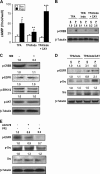The prostaglandin receptor EP2 activates multiple signaling pathways and beta-arrestin1 complex formation during mouse skin papilloma development
- PMID: 19587094
- PMCID: PMC2736303
- DOI: 10.1093/carcin/bgp168
The prostaglandin receptor EP2 activates multiple signaling pathways and beta-arrestin1 complex formation during mouse skin papilloma development
Abstract
Prostaglandin E(2) (PGE(2)) is elevated in many tumor types, but PGE(2)'s contributions to tumor growth are largely unknown. To investigate PGE(2)'s roles, the contributions of one of its receptors, EP2, were studied using the mouse skin initiation/promotion model. Initial studies indicated that protein kinase A (PKA), epidermal growth factor receptor (EGFR) and several effectors-cyclic adenosine 3',5'-monophosphate response element-binding protein (CREB), H-Ras, Src, protein kinase B (AKT) and extracellular signal-regulated kinase (ERK)1/2-were activated in 12-O-tetradecanoylphorbol-13-acetate (TPA)-promoted papillomas and that PKA and EGFR inhibition (H89 and AG1478, respectively) decreased papilloma formation. EP2's contributions to the activation of these pathways and papilloma development were determined by inhibiting endogenous TPA-induced PGE(2) production with indomethacin (Indo) and concomitantly treating with the EP2 agonist, CAY10399 (CAY). CAY treatment restored papilloma formation in TPA/Indo-treated mice and increased cyclic adenosine 3',5'-monophosphate and PKA activation as measured by p-CREB formation. CAY treatment also increased EGFR and Src activation and their inhibition by AG1478 and PP2 indicated that Src was upstream of EGFR. CAY also increased H-Ras, ERK1/2 and AKT activation, and AG1478 decreased their activation indicating EGFR being upstream. Supporting EP2's contribution, EP2-/- mice exhibited 65% fewer papillomas and reduced Src, EGFR, H-Ras, AKT and ERK1/2 activation. G protein-coupled receptor (GPCR) activation of EGFR has been reported to involve Src's activation via a GPCR-beta-arrestin-Src complex. Indeed, immunoprecipitation of beta-arrestin1 or p-Src indicated the presence of an EP2-beta-arrestin1-p-Src complex in papillomas. The data indicated that EP2 contributed to tumor formation via activation of PKA and EGFR and that EP2 formed a complex with beta-arrestin1 and Src that contributed to signaling and/or EP2 desensitization.
Figures






References
-
- Smith WL, et al. Cyclooxygenases: structural, cellular, and molecular biology. Annu. Rev. Biochem. 2000;69:145–182. - PubMed
-
- Hata AN, et al. Pharmacology and signaling of prostaglandin receptors: multiple roles in inflammation and immune modulation. Pharmacol. Ther. 2004;103:147–166. - PubMed
-
- Kawamori T, et al. Prostaglandin E receptor subtype EP(1) deficiency inhibits colon cancer development. Carcinogenesis. 2005;26:353–357. - PubMed
-
- Seno H, et al. Cyclooxygenase 2- and prostaglandin E(2) receptor EP(2)-dependent angiogenesis in Apc(Delta716) mouse intestinal polyps. Cancer Res. 2002;62:506–511. - PubMed
-
- Sung YM, et al. Lack of expression of the EP2 but not EP3 receptor for prostaglandin E2 results in suppression of skin tumor development. Cancer Res. 2005;65:9304–9311. - PubMed
Publication types
MeSH terms
Substances
Grants and funding
LinkOut - more resources
Full Text Sources
Medical
Molecular Biology Databases
Research Materials
Miscellaneous

